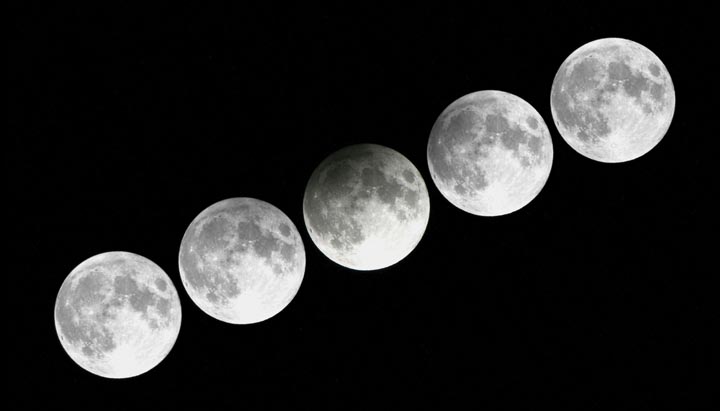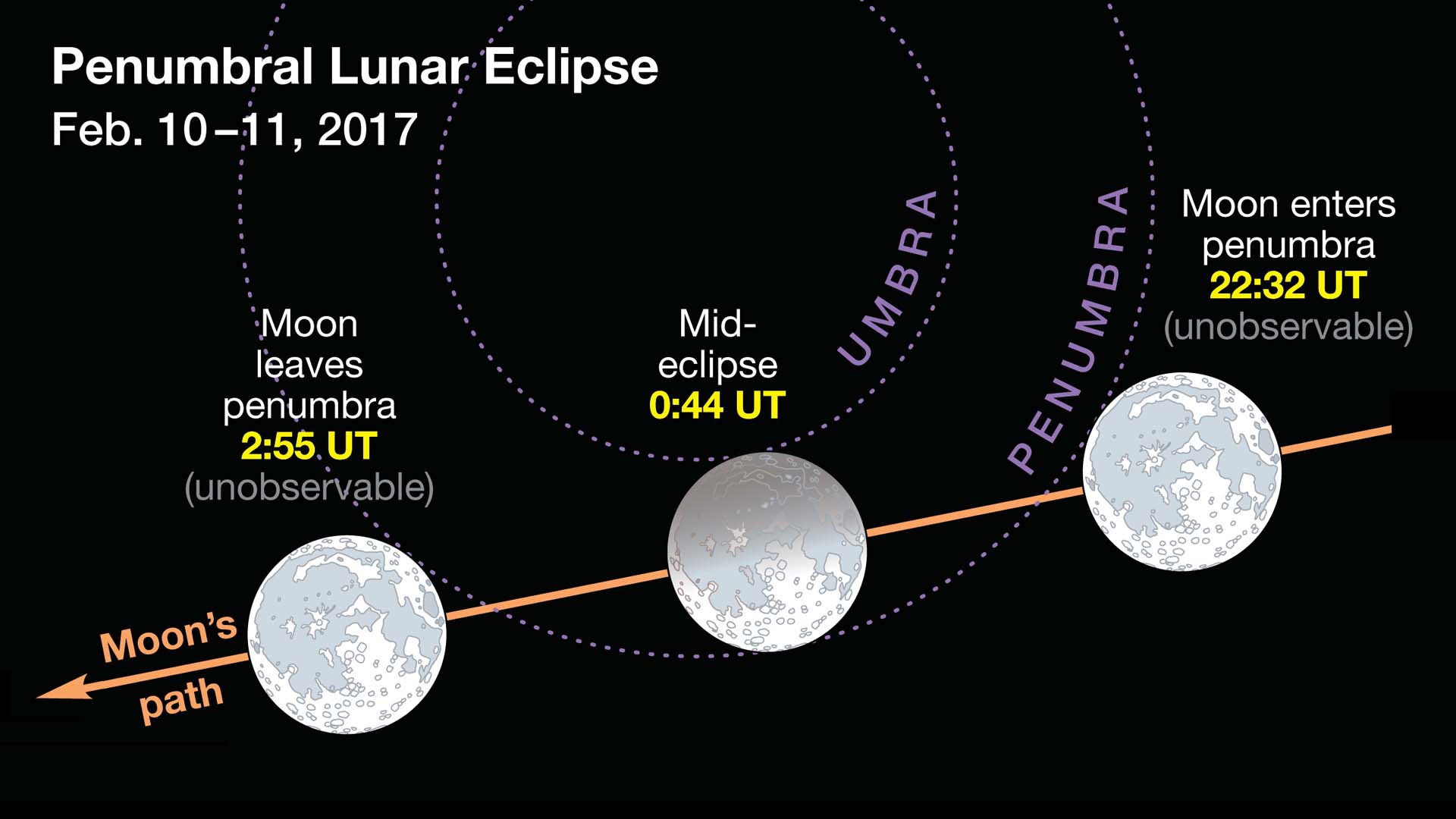North American observers can watch the Moon flirt with Earth’s shadow on the evening of February 10th.
No daytime shadow you normally see has a sharp edge. Instead, it’s always surrounded by a fuzzy perimeter — called the penumbra — created because the Sun is not a point source. A penumbra’s width, as seen from the shadow caster, is always equal to the angular width of the light source in the opposite direction.

Hoin Kong Space Museum
That’s why the penumbra of Earth’s shadow is almost exactly as wide as the Moon. Both the Sun and Moon appear very nearly the same width, about ½° across, as seen from Earth. And on February 10th, North Americans can watch the Moon plunge deeply into that dusky zone without actually touching the core of Earth’s shadow, the interestingly dark-red umbra, as happens during a partial or total lunar eclipse.
So a penumbral lunar eclipse is essentially a tease. But February's will be about the best one possible. The Moon’s northern limb will miss Earth’s umbra by only about 100 miles (160 km), or 3% of the Moon’s diameter. Although no bit of the Moon will go dark, the penumbral shading will be very plain to see.
Penumbral Lunar Eclipse: When and Where
Eastern North America, and all of Central and South America, will have a fine view of these shadowy happenings. In these locations twilight will be deepening or entirely over, and the full Moon will be shining well up in the eastern sky, by the time of maximum shading. Northeasterners can watch the whole progression from start to finish.
Seen from the central part of North America, the eclipse will be at maximum around or soon after moonrise and sunset, with the Moon still low in a bright sky. For those of you in the West, the Moon rises and the Sun sets after the eclipse has peaked. But even here you may be able to witness the subtle anomaly on the Moon fading away.
Europe, Africa, and western Asia have a trouble-free view, with the Moon high in a dark sky during the early morning hours of February 11th. Check out the times below:

Seeing is Believing
The outer part of Earth’s penumbra is so pale that you can’t detect it. You won’t see anything happening until the Moon’s edge has slid at least halfway in. For this event, that means about 90 minutes before mid-eclipse (which will come at 0:44 Universal Time on February 11th).
The shading will begin to show on the Moon’s left side, as seen in early evening from mid-northern latitudes. In North America, only from the northeastern U.S. and eastern Canada will the Moon be well up in time to watch for this. A lot will depend on how uniform any thin cloudiness may be, and on how much time and care you take to judge the reality of subtle impressions.

Sky & Telescope diagram
The passing minutes will gradually confirm your first correct judgments. By the time mid-eclipse approaches, the lopsidedness of the Moon’s illumination will be totally obvious. The shading will appear to become ever more concentrated toward the northern limb, because an umbra’s drop-off in brightness is always sharpest near its inner edge.
And then, as the Moon rises higher and any remaining twilight fades down, the process runs in reverse. This is the part of the eclipse that most Americans will be able to see best. How long can you definitely hold a trace of shading with your eyes, and with a telescope? Will 90 minutes after mid-eclipse really be the last time anything is visible? Use this eclipse as a check on the acuteness of your visual perception!
Can't see the eclipse? If it's cloudy at your location, or if the eclipsed Moon isn't in view, you can watch vicariously via live webcasts provided by the Virtual Telescope Project.
 7
7









Comments
Robert-Casey
February 3, 2017 at 5:07 pm
And in 6 months we'll have that solar eclipse.
You must be logged in to post a comment.
Capella80
February 6, 2017 at 12:51 pm
I happen to be right in the middle of it.
You must be logged in to post a comment.
Graham-Wolf
February 8, 2017 at 12:19 am
Best wishes to all you Americans... we won't see it from NZ, but have seen dozens in my 60 plus years or so. It's one for you folk over there. Enjoy! Regards from 46 South, NZ. Graham W. Wolf.
You must be logged in to post a comment.
Dr John D Bernard
February 8, 2017 at 10:59 am
Alan is dead on the money... with superb detailing for the Friday night lunar. At 71, I have always enjoyed for over 30 years his take on astronomical events, and that of Fred Espenak for eclipses. This lunar is just the prelude to the greatest American eclipse of our life time: August 21, 2017.
My high school students who shot the 1970 solar eclipse, and some are now with our 2017 SC Total Eclipse Group, have established three sites [Greenville, Columbia, and Charleston, SC] for capturing this solar eclipse. Because of the heavy overcast in 1970 from Perry, Florida to mid - North Carolina, not many people got a nice clear view of that eclipse. We found a hole in the clouds by driving north into NC at 3 am in the morning... shot over 200 photos and 3 minutes of 16mm video on a Bolex camera mounted on a six inch Cave reflector. As a matter of fact, these same students may be 1 in a 100 Americans to have successfully photographed 2 American solar eclipses in our lifetime. All their 1970 photos/movies, and 2017 plans can be seen at:
http://www.jupiterspacestation.org/solarEclipse/eclipse.html
The South Carolina government will be a supportive host, but If you are among the estimated one million people coming to SC to the mid-line for the solar eclipse, you might want to take a look at our SC Planning and Tips web page to steer clear of some of the ensuing chaos.
You must be logged in to post a comment.
Kenneth Heisler
February 10, 2017 at 4:46 pm
So is what we call a partial eclipse of the Sun what an observer on the Moon would call a penumbral eclipse of the Earth? (!)
Kenneth A. Heisler, M.D.
You must be logged in to post a comment.
Dr John D Bernard
February 13, 2017 at 6:28 pm
A moon shadow on the earth could be either a partial or a total eclipse of the earth as seen by a moon observer. Since the relative distance between the bodies, at an instance of time, dictates which kind of eclipse you see, only a computer model or simulation could determine whether a total Earth eclipse could or has actually happened (as seen by an observer on the moon). But in the recorded history of mankind there has never been a total eclipse of the Sun where all places on Earth were covered in totality.
But interestingly so, all observers on the Sun are always treated to a transit of Earth in all partial Earth eclipses..
Kenneth, here is what I like about your question: it totally eclipses the box.
You must be logged in to post a comment.
MikeOxlong89
February 14, 2017 at 12:13 pm
Can't wait to see this
You must be logged in to post a comment.
You must be logged in to post a comment.